bop-1.gif) image
by Martin Grieve, 08 Dec 2006
image
by Martin Grieve, 08 Dec 2006
Last modified: 2015-12-08 by bruce berry
Keywords: south africa | homeland | bophutatswana | leopard's face | bop |
Links: FOTW homepage |
search |
disclaimer and copyright |
write us |
mirrors
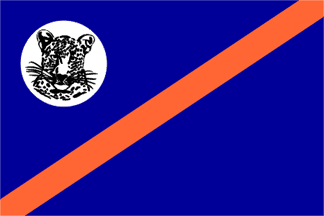 image
by Martin Grieve, 08 Dec 2006
image
by Martin Grieve, 08 Dec 2006
Within the "old" South Africa, 10 homelands were created, four of which
were granted "independence" by South Africa (not recognised by any other
country in the world). Bophuthatswana was one of the four so-called
"independent" homelands having been granted independence by South
Africa on 06 December 1977. All the former South African Homelands/bantustans
ceased to exist as political entities on 27 April 1994. They have all (including the former so
called independent Homelands) been reincorporated into South Africa.
The flags of the former Homelands are no longer in use (either officially
or unofficially).
Bruce Berry, 25 April 1996
Bophuthatswana was a relatively large territory, vastly dispersed across the
central to western
Transvaal and into the north-eastern
Cape Province (today's northwestern-most
Mpumalanga
and North-West Province). Six main parts, three of which,
smaller, in Transvaal (with the easternmost one briefly bordering
KwaNdebele),
and two other (one of which quite large) in the Cape
Province; the sixth,
very uncompact shaped unlike the others, stretching between the two provinces
and extensively bordering Botswana.
Antonio Martins, 30 May 1999
There was a portion of Bophuthatswana in Orange
Free State at Thaba Nchu - about 50 km east of Bloemfontein (today
in the Free State province).
Bruce Berry, 31 May 1999
The design of the flag of Bophuthatswana was originally set out in section
2 of the Bophuthatswana Flag Act of 1972, which reads as follows:
"The Bophuthatswana flag shall be Azure with a bar sinister Tenne,
in Dexter chief a roundel Argent charged with a leopard's face Sable pied
Argent.
The width of the flag shall be equal to two-thirds of its length.
The width of the bar shall be one-twelfth of the length of the flag.
The diameter of the roundel shall be one-quarter of the length of the
flag".
The blue symbolises the infinity of the sky and the striving for progress
and development. The orange bar refers to the golden path which must be
taken by the Tswana people in order to bring this development to fruition.
The leopard's face is symbolic of the authority necessary to lead the people
to the development of their potential. Leopards are traditional symbols
of authority for the Tswana people.
The flag was taken into use on 19 April 1973 after the homeland achieved
internal self-government on 01 June 1972.
The flag remained unchanged when the homeland became "independent"
on 6 December 1977 and a description of this flag was incorporated into
section 2 of the Republic of Bophuthatswana Constitution Act.
Bophuthatswana was re-incorporated into South Africa on 27 April 1994
and ceased to exist as a separate political entity and the flag is no longer
in use.
Bruce Berry, 01 Dec 1998
bop-1.gif) image
by Martin Grieve, 08 Dec 2006
image
by Martin Grieve, 08 Dec 2006
In the Bophuthatswana flags the leopard's head seems to be the one really
used. Perhaps it was taken from the first design adopted by the Legislative
Assembly in 19 April 1972, that was red over green horizontal with white
circle in center and within it a leopard's head and rejected November 1973
when the well know flag was adopted.
Jaume Ollé, 12 Apr 2001
Regarding the former flags of the South African homelands;
- how much did the actual flags of the homelands differ from the original
specifications, and why?
- how much variation was in between different specimens of the same flag?
- what is the reason for the widely differing representations in flag
publications?
Marcus Schmöger, 28 Jan 2007
The simple answer to the questions is manufacturer's licence. There was some
variation in the flags made by the various manufacturers, most notably the
detail for the leopard's head in the flag of Bophuthatswana and the Blue Crane
in the flag of Ciskei. As reported on FOTW, despite the
specifications of the
Ciskei flag as described in the Ciskei Flag Act not conforming to the official
art-card, the proportions of the blue and white stripes were followed as per the
art-card and not as per the specifications. This could possibly explain the
variations in various flag publications (which was actually the official
specification???). However, one manufacturer produced flags showing the twig in
the beak of the Blue Crane (as was the case in the Coat of Arms) although this
was never specified for the flag. This manufacturer subsequently won a Ciskei
Government contract to supply flags and despite the error being pointed out (by
me actually!!!), the flags were made and the contract honoured!
The majority of the variations were with the Ciskei flag, while the others were
quite minor being mainly different colour shades and in the case of
Venda, different fonts were used for the "V".
Bruce Berry, 08 Feb 2007
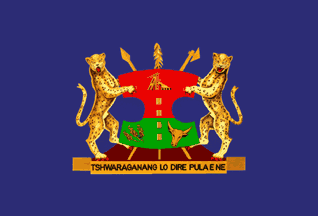 image by Jens Pattke, 13 Jan 2013
image by Jens Pattke, 13 Jan 2013
The Presidential standard of the President of Bophuthatswana
has a dark blue field, in the centre of which is the national
coat of arms of Bophuthatswana. This design is the same as
that of the flag used by the President of South Africa
between 1961 and 1983, which in turn is based on the design of the flag used by
the Governor-General of South Africa between 1931 and
1961.
There is some debate as to whether this flag was actually flown, although there
is photographic evidence of it being used as a car flag.
Following the re-incorporation of Bophuthatswana into South Africa on 27 April
1994, the post of President of Bophuthatswana was abolished and consequently
this flag is no longer in use.
Bruce Berry, 13 Jan 2013
Flaggenmitteilung 102 mentions an orange presidential flag
with narrow border of blue and white stripes in four sides, with arms in
center. It also mentions a distinctive car-flag as being a
black flag bordered yellow, with a white circle in centre containing the
arms.
Jaume Ollé, 12 Apr 2001
 image by Martin Grieve, 08 Dec 2006
image by Martin Grieve, 08 Dec 2006
The flag of the Bophuthatswana Army
is in proportion 2:3 and consists of three equal vertical stripes of orange,
green and orange, charged with the Bophuthatswana Defence Force badge in the
centre of the green stripe. The badge comprises a yellow roundel bearing a
leopard's face surper-imposed on a yellow spear and Tswana battle axe in saltire.
The leopard's face is taken from the Bophuthatswana national flag.
The flag ceased to be used following the re-incorporation of
Bophuthatswana into South Africa on 27 April 1994.
Bruce Berry, 08 Dec 2006
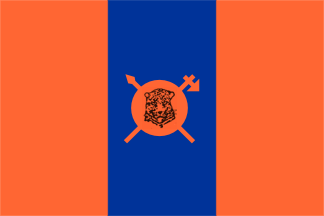 image by Martin Grieve, 08 Dec 2006
image by Martin Grieve, 08 Dec 2006
The flag of the
Bophuthatswana Defence Force is in proportion 2:3 and consists of three equal
vertical stripes of orange, blue and orange, charged with the Bophuthatswana
Defence Force badge in the centre of the green stripe. The badge comprises an
orange roundel bearing a leopard's face surper-imposed on a orange spear and
Tswana battle axe in saltire. The leopard's face is taken from the
Bophuthatswana national flag.
The flag ceased to be used following the re-incorporation of
Bophuthatswana into South Africa on 27 April 1994.
Bruce Berry, 08 Dec 2006
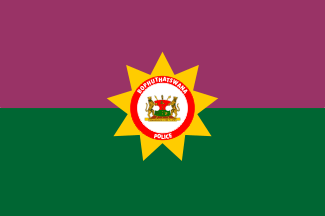 image
by Martin Grieve, 08 Dec 2006
image
by Martin Grieve, 08 Dec 2006
The Bophuthatswana Police flag registered with the South African Bureau of Heraldry
on 20 February 1984 with the following description:
A rectangular flag, proportions three by two, consisting
of two horizontal bands of equal width, maroon over green, charged in the
centre with the badge of the Bophuthatswana Police (to wit: a facetted
nine-pointed star Or, charged with an annulet Murry bearing the name BOPHUTHATSWANA
POLICE in letters Or, there-within on a plate the arms of the Republic
of Bophuthatswana, proper).
Source: Data
of the Bureau of Heraldry on registered heraldic representations.
Mark Sensen, 19 May 2002
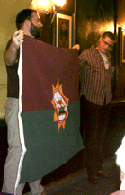 sent
by Jens Pattke, 15 Nov 2004
sent
by Jens Pattke, 15 Nov 2004
Here is a photo from the German Vexillological Meeting in held in Jena, 2004.
The Bophuthatswana Police flag is horizontally divided dark red (to brown) and
green with the police badge in the centre. Thanks to flag supporters Jorg Karaschewski and Dr. Andreas Herzfeld. Both
vexillologists are members of German Vexillological Society.
Jens Pattke, 15 Nov 2004
bop-p.gif) image by Martin Grieve, 08 Dec 2006
image by Martin Grieve, 08 Dec 2006
The flag of the Bophuthatswana Police
is in proportion 2:3 and consists of two equal horizontal stripes of maroon over
olive green. The badge of the Bophuthatswana Police is placed in the centre of
the flag and comprises a yellow nine-pointed star charged in the centre on a
white field with the coat of arms of Bophuthatswana in full colour within a red
annulet bearing the words BOPHUTHATSWANA POLICE in white letters.
The flag ceased to be used following the re-incorporation of Bophuthatswana
into South Africa on 27 April 1994.
Bruce Berry, 08 Dec 2006
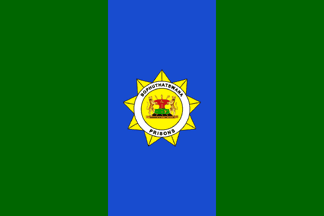 image by Jens Pattke, 13 Jan 2013
image by Jens Pattke, 13 Jan 2013
The flag of the Bophuthatswana Prisons Service follows the same design as that of the Bophuthatswana Defence Force and consists of three equal vertical stripes of green, blue and green with the badge of the Bophuthatswana Prisons Service placed in the centre of the blue stripe. The badge is a gold facetted nine-pointed star bearing, in the centre, on a yellow field, the coat of arms of Bophuthatswana in full colour within a white ring with the words BOPHUTHATSWANA PRISONS in black letters.
bopri.gif) image by Jens Pattke, 13 Jan 2013
image by Jens Pattke, 13 Jan 2013
Following the re-incorporation of Bophuthatswana into South Africa on 27
April 1994, this flag is no longer in use and the flag of the
South African
Department of Correctional Services is flown, alongside the South African
national flag, at all prisons.
Bruce Berry, 13 Jan 2013
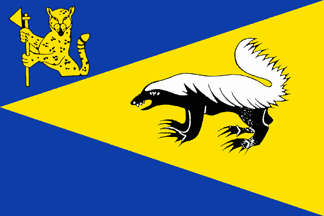 image
by Jens Pattke, 19 Aug 2012
image
by Jens Pattke, 19 Aug 2012
The flag of the
Bophuthatswana Internal Intelligence Service was registered with the South
African Bureau of Heraldry on 19 April 1985 with the following description:
On a blue flag, proportions three by two, an old gold
pile reversed charged with a ratel statant proper, in the canton a demi-leopard gardant also proper, holding in its forepaws a gold Tswana
battle-axe erect.
Source: Data
of the Bureau of Heraldry on registered heraldic representations.
This flag ceased to be used following the re-incorporation of
Bophuthatswana into South Africa on 27 April 1994.
Mark Sensen, 19 May 2002
bop.gif) scan by Bruce Berry, 08 Dec 2006
scan by Bruce Berry, 08 Dec 2006
By Government Notice No. 1599, published in the South African Government Gazette (Number 3644 of 08 September 1972) it was notified that a coat of arms had been registered for the Tswana Legislative Assembly in terms of the South African Heraldry Act (Act No. 18 of 1962). Although application and registration was made in terms of the Heraldry Act (Government Notice 1599 in Government Gazette 3644 of 08 September 1972), the State Herald did not issue a formal certificate of registration in respect of these arms as they had been devised without consultation of the Bureau of Heraldry.
These Arms were retained by Bophuthatswana at independence and are described and illustrated in Section 2 of the Republic of Bophuthatswana Constitution Act (Act No. 18 of 1977). The blazon of the coat of arms is described as:
Arms:
Per fess (at nobril point) Gules and Vert, in chief a mine headgear, in base
dexter three grain sorghum ears seeded in bend, and sinister an ox head caboshed
in bend sinister, the shield interlaced palewise of a traditional plumed staff;
behind the shield an assegai and battle-axe in saltire, Or.
Supporters: Two leopards gardant proper.
Motto: TSHWARAGANANG
LO DIRE PULE E NE (If
we stand together and work hard we will blessed with rain)..
With the re-incorporation of Bophuthatswana into South Africa in April 1994,
these Arms are no longer in use.
Bruce Berry, 01 Dec 1998